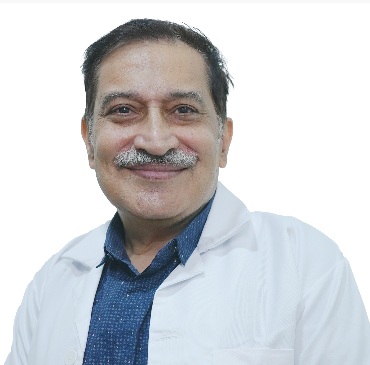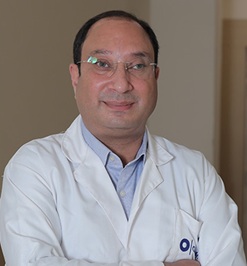Reverse Shoulder Replacement - Surgery, Technique & Recovery Time

Treatment Duration
2 Hours
------ To ------3 Hours
Treatment Cost
₹ 3,00,000
------ To ------₹ 5,00,000

Table of Contents
- What is Reverse Shoulder Replacement?
- Conditions treated with Reverse Shoulder Replacement
- Who needs Reverse Shoulder Replacement?
- How is Reverse Shoulder Replacement performed?
- What to expect before and on the day of Reverse Shoulder Replacement?
- What to expect after Reverse Shoulder Replacement?
- Benefits of Reverse Shoulder Replacement
- Risks and complications of Reverse Shoulder Replacement
- Risks of delayed Reverse Shoulder Replacement
- Cost of Reverse Shoulder Replacement
A Reverse Shoulder Replacement surgery is a special type of surgical procedure done to remove the damaged parts of the shoulder and replace them with artificial parts. Reverse shoulder replacement surgery is often advised in case of arthritis with a large rotator cuff tear.
A reverse shoulder replacement surgery is performed by an orthopaedic surgeon. The procedure takes about 2 to 3 hours to complete. The procedure has a high success rate and most patients can resume a normal lifestyle within months.
| Surgery Name | Reverse Shoulder Replacement |
| Disease Treated | Arthritis, Severe rotator cuff injury, Proximal humerus fracture, Tumour in the upper part of the humerus |
| Benefits of the Surgery | Restoration of shoulder strength, Joint stabilization, Better range of motion, Less pain |
| Treated by | Orthopaedic surgeon |
You can check Reverse Shoulder Replacement Cost here.
What is Reverse Shoulder Replacement?
A Reverse Shoulder Replacement is a surgical procedure done to remove the damaged parts of the shoulder and replace them with artificial parts. This procedure is often advised in case of arthritis with a large rotator cuff tear.
Anatomy and Physiology of the Shoulder Joint
The shoulder is one of the largest and most complex joints in the human body. The shoulder joint can also be referred to as the glenohumeral joint due to its structure that involves the humeral head and glenoidal cavity of the scapula (shoulder blade). It forms a ball and socket joint between the upper arm bone (humerus) and the scapula (shoulder blade). This allows a wide range of movement and strong support to the arm. Other important bones in the shoulder include:
- The acromion is a bony projection off the scapula.
- The clavicle (collarbone) meets the acromion in the acromioclavicular joint.
- The coracoid process is a hook-like bony projection from the scapula.
Other important structures of a shoulder joint include:
- Rotator cuff: It is a group of tendons and muscles surrounding the shoulders, supporting and allowing a wide range of motion.
- Bursa: A small sac of fluid that works as a cushion and gliding surface to reduce the friction between the tissues and protect the tendons of the rotator cuff.
- Labrum: A type of cartilage that cups the ball-like structure formed by the humerus at the top of the upper arm.
Expert Doctors (10)
NABH Accredited Hospitals (10)


Conditions treated with Reverse Shoulder Replacement
Reverse shoulder replacement is mainly considered when the patient has certain shoulder injuries, such as a severe rotator cuff injury. Reverse shoulder replacement can also treat conditions such as:
- Significant pain and a limited range of motion due to arthritis of the shoulder joint.
- Inability to lift the arm due to torn or missing rotator cuff tendons. This condition may or may not be painful for the patient, but it does hamper daily life activities significantly.
- Persistent pain after a total shoulder replacement surgery. In this case, implanting a reverse prosthesis is required to get relief from pain and improve the motion of the arm.
- Certain types of fractures in the shoulder area, especially the proximal humerus fracture in which the upper part of the arm bone (where the ball attaches to the shaft of the bone) is broken. In a proximal humerus fracture, the humeral head gets broken or ruptured.
- A tumour in the upper part of the humerus, which connects to the shoulder, may also require reverse shoulder replacement.
Who needs Reverse Shoulder Replacement?
Patients with severe pain or weakness in their shoulder that makes it difficult to do daily activities may need a reverse shoulder replacement. Mostly, these conditions are treated with total replacement surgery, but patients with rotator cuff injuries require a reverse prosthesis. As the torn rotator cuff can no longer support the shoulder joint, the total replacement surgery may leave behind the pain and limited movement of the arm.
But the reverse shoulder replacement allows the patient to lift his or her arm using the deltoid muscle (which helps move the arm up and away from the body) instead of the rotator cuff for a wide range of movement.
A reverse shoulder replacement procedure is required for patients who have:
- An irreparable rotator cuff tear
- Cuff tear arthropathy: shoulder arthritis with a large rotator cuff tear
- Pain that has not improved even after undergoing total shoulder replacement surgery
- A chronic shoulder dislocation
- A tumour of the shoulder joint
- Fracture of the shoulder joint involving the breaking of the shaft bone or splitting of the ball (at the upper part of the humerus)
How is Reverse Shoulder Replacement performed?
Reverse shoulder replacement is an effective treatment to improve pain and increase the range of motion. The procedure generally takes about 2 to 3 hours to complete depending on the patient's age, medical condition of the patient and the complexity of the case. The procedure is done under general anaesthesia to keep the patient comfortable. An orthopaedic surgeon along with other professional medical staff performs this procedure. The following steps are involved in the procedure:
- At first, an anaesthesiologist induces a nerve block and/or general or regional anaesthesia as per the patient’s preference. (General anaesthesia renders the patient sleepy during the operation, whereas regional anaesthesia only numbs the surgical area while the patient remains awake.)
- The surgeon will then check the vital measures of the patient such as the heart rate, oxygen concentration, and blood pressure throughout the procedure.
- Ones the patient is stable after administering the anaesthesia, the surgeon makes an incision at the front or top of the shoulder to expose the muscle layer underneath.
- The surgeon then cuts through the muscle layer to remove the damaged parts of the humerus and scapula.
- Once the damaged part is removed, the surgeon fits the reverse prosthesis i.e., the metal ball will be attached to the scapula and the plastic socket to the upper part of the bone with the help of screws.
- The surgeon will then drain out the extra fluid from the joint with the help of a tube (the tube is removed later).
- Finally, the surgeon checks that the prosthesis is in the right position and closes the incisions in the muscles and skin with the help of sutures or stitches.
What to expect before and on the day of Reverse Shoulder Replacement?
Reverse shoulder replacement surgery generally requires the patient to stay in the hospital for a few days, depending on his or her health condition. To prepare for the day of surgery, the patient must consider the following things:
Before Reverse Shoulder Replacement
Before undergoing the reverse shoulder replacement procedure, the following things would be done:
- The patient must tell the doctor about all the vitamins, herbs, and medicines, including over-the-counter medications such as aspirin, that he or she takes.
- The patient must ask the doctor if taking blood thinners is safe before the surgery.
- The patient must also confirm if any other type of medication needs to be avoided.
- The patient must ask the doctor if fasting is required on the night before the surgery.
- The patient must follow all the instructions given by the doctor.
To get a piece of detailed information about the shoulder, the doctor may ask for the following tests before the surgery:
- X-ray
- CT scan to check the condition of the bones
- MRI to get a detailed view of the soft tissues around the bones
Note: The patient may also need to donate one unit of blood before the surgery. After the operation, this blood is transfused (given back) to him or her if needed. The patients usually don’t require a blood transfusion if they undergo shoulder replacement for the first time. However, in revision cases, around 80 per cent of patients need a blood transfusion because the procedure is more complex and the duration of the surgery is longer.
On the day of Reverse Shoulder Replacement
- The patient should reach the hospital before the scheduled surgery time.
- The patient will be asked to sign the consent form before the surgery.
- The patient is made to change into a hospital gown.
- Jewellery, glasses, hearing aids, dentures, contact lenses, and any other accessories the patient wears are removed.
- The doctor may ask questions related to the patient’s medical history. These questions can be similar to the ones asked before.
- The patient is taken to the operation room or the Pre Anaesthesia Unit (PAU) to start an IV line in the arm to supply medications and IV fluids. The medications help the patient relax and put him or her in a sleep-like condition.
- The surgical area (including the chest, shoulder, and upper arm) is shaved and cleaned using an antiseptic solution.
- The healthcare providers monitor the patient’s vitals throughout the surgery.
- Once the surgery starts, the family of the patient is informed, and the healthcare providers update them at regular intervals about the patient’s condition.
- Once the surgery is performed, the patient is taken to a recovery room. Here the patient is monitored until his or her health condition becomes stable.
What to expect after Reverse Shoulder Replacement?
The following things can be expected after the reverse shoulder replacement procedure:
The recovery process at the hospital
- Post-surgery, the patient will be moved to the hospital ward so that he/she can recover.
- The patient will be kept in observation until the after-effect of anaesthesia wears off.
- The patient may not feel any movement in the operated arm due to the effect of anaesthesia. He or she may also feel no movement in the fingers or hands for several hours until the effect lasts.
- Experiencing pain is normal after the operation. The doctors provide pain relieving medicines as required.
- The healthcare provider may also give doses of antibiotics to reduce the risk of infection.
- The patient will be asked to use an ice pack on the shoulder.
- The patient may need to remain admitted for 2 to 3 days, depending on his or her health condition.
- The doctor may recommend physical therapies while the patient is in the hospital.
- The doctor will conduct imaging procedures to ensure the surgery was successful.
- The patient’s arm will remain in a sling for several weeks.
Recovery process/expectation after hospital discharge
- Instructions provided by the doctor must follow at home.
- The patient may feel pain for several days. The doctor will prescribe medications, including opioids, non-steroidal anti-inflammatory drugs (NSAIDs), and local anaesthetics for pain management and relief.
- Home exercises and continued icing of the shoulder are necessary to improve pain and the shoulder’s range of motion.
- The patient can resume daily activities that involve using the wrist and hands, such as eating, dressing, or using a keyboard, within a few days after the surgery. However, it can take several weeks before the patient can start using his or her arm.
- A normal diet can be started as soon as the patient feels like it. Proteins, fat, and a carbohydrate-rich diet would help regain muscle strength and improve healing after the surgery.
- Wound care:
- The dressing on the surgical area must be kept in place till the follow-up visit. It may get wet while taking a bath, but it is best to keep it dry if possible.
- It is not necessary to avoid water touching the wounds. But the patient must pat the wounds dry. He or she must also ensure not to keep the shoulder under water for at least four weeks after the surgery.
- Restrictions:
- No ointment, lotion, or alcohol must be applied to the incisions unless prescribed by the doctor.
- Extreme positions, such as using the arm to reach behind the back or raising it above the head, must be avoided. The patient must also observe which positions puts pressure on the shoulder while lying on the back or sitting in a chair. These positions must also be avoided to reduce pain.
- The sling must not be removed until the doctor says so. Freeing the arm early will affect its recovery and healing. The sling may need to be released while doing some exercise. The doctor will give proper instructions regarding that.
- Lifting anything heavier than five lbs. for the first six weeks after the surgery is unsafe for the shoulder.
- Pushing out of bed or chair requires forceful muscle contractions. So, the patient must gently get up from the bed or chair.
- The patient must stop driving for around two months as driving can lead to persistent pain and even shoulder dislocation.
- Tobacco slows the recovery of the muscles and bones, which can also increase the risk of infection. So, smoking must be avoided after the surgery.
- Recovery: The recovery can be different from person to person. After rehabilitation, the patient experiences significant pain relief and an improved range of motion. However, the amount of movement recovered depends upon certain factors, such as bone healing around the base plate and screws and also the amount of motion the patient had before the surgery.
First follow-up appointment
- The first follow-up visit is usually scheduled one week after the surgery.
- During the visit, the doctor will recommend an X-ray imaging to check the status of the implant and see if the shoulder is properly healing.
- The doctor may also remove the dressing from the incision site if the healing is done.
- The doctor might also change the medication or advise the patient to continue with the previous medication for some more time, depending on the condition and recovery of the surgical area.
- The patient will also be informed regarding future visits to examine if the implant is in place and functioning properly.
Benefits of Reverse Shoulder Replacement
Reverse shoulder replacement is known to be an effective solution to provide pain relief. Studies indicate a high reverse shoulder replacement success rate, with more than 90 per cent of reverse prostheses lasting more than ten years. The benefits of reverse shoulder replacement include:
- The shoulder doesn’t rely on the rotator cuff: The reverse shoulder replacement procedure reverses the ball and socket placement. Due to this, the shoulder relies on the deltoid muscle (which protects and stabilises the shoulder joint) for support and motion rather than the injured rotator cuff.
- Strength of the shoulder is restored: Shoulder arthritis or torn rotator cuff can weaken the joint, causing instability, pain, and reduced mobility. Reverse shoulder replacement helps in restoring the strength and stability of the joint.
- Joint stabilization: Rotator cuff tears and arthritis weaken the shoulder joint causing pain, loss of motion, and instability. With reverse shoulder replacement, the joint is strengthened and stabilized.
Risks and complications of Reverse Shoulder Replacement
Like any other surgery, the reverse shoulder replacement procedure also has some potential risks and complications, such as:
- Loosening or dislocation of the prosthesis
- Post-operative infection
- Nerve damage during the surgery
- Bleeding
- Tingling
- Numbness
- Weakness
- Blood clotting in the legs
When is consultation with the doctor needed?
The patient must consult the doctor immediately if he or she experiences:
- Severe pain in the shoulder for a week
- Bleeding
- Immobilization of the joint
- Swelling in the arm
Risks of delayed Reverse Shoulder Replacement
Research has found that delaying a reverse shoulder replacement can lead to:
- Severe pain
- Wearing away the valuable bone
- Dislocation of the shoulder
- Increase the complications in the shoulder joint
- Bursitis, tendinitis and a rotator cuff tear
Cost of Reverse Shoulder Replacement
The cost of reverse shoulder replacement ranges from ₹3,00,000 to ₹5,00,000. The cost varies based on the following factors:
- Age of the patient
- Type of the procedure done
- Technique and equipment used
- The medical condition of the patient
- The type of hospital facility availed - individual room or shared.
| Procedure Name | Cost Value |
| Reverse Shoulder Replacement | ₹3,00,000 to ₹5,00,000 |
Frequently Asked Questions (FAQ)
What are the myths versus facts about reverse shoulder replacement?
- Myth: The patient has to take painkillers throughout his or her lifetime to deal with pain after the surgery.
Fact: This is not true. Pain after surgery is part of the healing process. The doctors prescribe pain relieving medications until the recovery period. After that, there is no requirement for painkillers. - Myth: The patient will never be able to lift heavy weights after the surgery.
Fact: Lifting heavy weights for the first six weeks after the surgery is restricted, but after that, the patient can do so with the doctor’s permission. - Myth: The results of the surgery are often disappointing.
Fact: Reverse shoulder replacement is considered a highly successful procedure to reduce pain and increase mobility in the shoulder joint. So, it wouldn’t be right to say that the results are disappointing. - Myth: The implants used in the surgery are not durable and cannot be relied upon.
Fact: Research shows that more than 90 per cent of the prosthesis used last more than ten years. So, the above statement is a myth.
Is reverse shoulder replacement considered major surgery?
In a reverse shoulder replacement procedure, a reverse prothesis is implanted to replace the damaged bones in the ball and socket joint of the shoulder. It is considered major surgery that may require the patient to stay in the hospital for several days.
What is the success rate of reverse shoulder replacement?
Reverse shoulder replacement is an effective treatment approach to provide pain relief. Study shows that 90 per cent of reverse implants last for more than ten years.
What is the downside of reverse shoulder replacement?
Like any other surgery, reverse shoulder replacement bears the risk of complications, such as infection, joint instability, and bone fracturing around the implants.
How long does recovering fully from a reverse shoulder replacement surgery take?
Although the patient may resume normal activities like eating, dressing, and grooming after a few days of the surgery, full recovery may take up to four months.
Can I reach behind my back after undergoing a reverse shoulder replacement surgery?
The placement of the implants in reverse doesn’t allow the patient to reach behind the back. This is why the range of motion after the surgery is limited to the lower back or posterior hip. Activities like putting on a bra can get difficult for the patient.
Which is worse, shoulder replacement or reverse shoulder replacement?
The preference of treatment approach depends on the patient’s health condition. If he or she has a severe rotator cuff injury, reverse shoulder replacement would be the most suitable option.
How do you wipe yourself after a reverse shoulder replacement surgery?
The toileting ability of the patient doesn’t get affected after the surgery. He or she can use either of the arms to manage the toileting.
What does a shoulder look like after a reverse shoulder replacement?
The reverse shoulder arthroplasty slightly increases the shoulder’s length (approx. ½ inch). But it is barely noticeable.
What happens if reverse shoulder replacement fails?
Failure of the reverse shoulder replacement may lead to persistent pain, stiffness, weakness and loss of function in the arm.
How much weight can someone lift after reverse shoulder replacement?
Not lifting more than 20 pounds of weight is recommended after reverse shoulder replacement. The patient must also avoid repetitive overhead movements.
Can you get a full range of motion after reverse shoulder replacement?
The reverse prosthesis aims to improve the range of motion that was lost due to arthritis or a rotator cuff injury. It may not bring back the normal range of motion, though.
What happens to rotator cuff muscles after reverse shoulder replacement?
The injured rotator cuff muscles cannot provide support and movement to the shoulder. This is why reverse shoulder replacement relies on deltoid muscle to enhance the arm’s stability and movement.
Can I take my sling off for sleep?
No, the patient must sleep wearing a sling in a recliner or reclined bed after the surgery to avoid putting the arm in a bad position.
What is the cost of reverse shoulder replacement?
The cost of a reverse shoulder replacement procedure ranges from ₹3,00,000 to ₹5,00,000.
Why does the cost of reverse shoulder replacement vary for different patients?
The cost of reverse shoulder replacement differs due to factors including the patient’s age, the type of procedure done, techniques and equipment used, the type of hospital, and the admission room that a patient opts for.
Does insurance cover reverse shoulder replacement surgery?
Yes, all health insurance plans cover reverse shoulder replacement surgery. Paperwork is facilitated by our team on your behalf ensuring smooth approval and a cashless facility. Contact HexaHealth for a simple cashless and hassle-free experience.
Last Updated on: 17 September 2022
Author
HexaHealth Care Team
HexaHealth Care Team brings you medical content covering many important conditions, procedures falling under different medical specialities. The content published is thoroughly reviewed by our panel of qualified doctors for its accuracy and relevance.






















